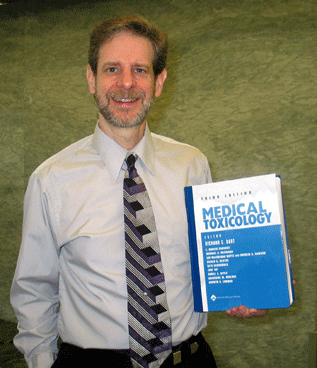 The skin of a rattlesnake stretches across the office wall of Steven Seifert, M.D., at the Nebraska Regional Poison Center, where he is medical director.
The skin of a rattlesnake stretches across the office wall of Steven Seifert, M.D., at the Nebraska Regional Poison Center, where he is medical director.
The unfortunate rattlesnake bit a patient of Dr. Seifert’s.
The patient then stomped the snake to death and brought it to Dr. Seifert for identification.
“We don’t recommend doing that,” said Dr. Seifert, professor of medical toxicology in the department of surgery, section of emergency medicine at UNMC. “We don’t need the snake, we treat the patient by what we see clinically, and trying to capture or kill it just increases the likelihood that we’ll have a second bite to deal with.”
The deadly snake is representative of the many poisonous snakes mentioned in “Medical Toxicology” 3rd Edition, (Lippincott Williams & Wilkins, $200), to which Dr. Seifert contributed 15 chapters.
“The book addresses the full spectrum of toxic agents,” Dr. Seifert said “It’s meant to be both comprehensive and useful in the management of acute poisoning.”
Dr. Seifert is one of 11 major contributors to the book. The topics he covers in the book include a chapter on spider anti-venoms, unexplained acid-based disorders and food-borne illnesses.
“The book is designed for easy access, with consistent organization, clear tables and charts to provide at-a-glance information for quick reference,” Dr. Seifert said. “We hope it finds its way into the emergency department of every hospital in the country, as well as other acute care settings.”
Dr. Seifert donated a copy of the book to the poison center, and UNMC also has purchased a copy of the book for the emergency room, he said.
Dr. Seifert became involved with the book when asked by the editor, Richard C. Dart, M.D., Ph.D., director of the Rocky Mountain Poison and Drug Center in Denver, Colo., where Dr. Seifert completed his toxicology fellowship.
After more than two years of writing, the book went to print Dec. 15, 2003. It is a complete revision of the second edition, which lacked consistency in tone and organization as a result of the untimely death of the previous editor and original author, Matthew Ellenhorn.
“Reviews are pending,” Dr. Seifert said. “But we’re expecting the book to reclaims its place as the premier toxicology text.”